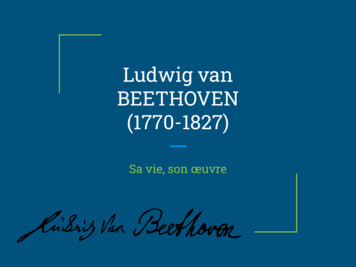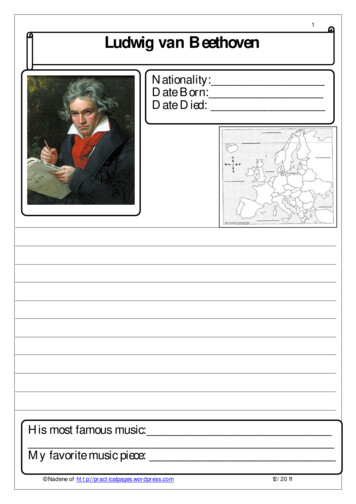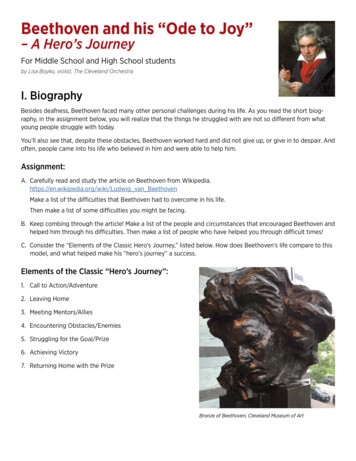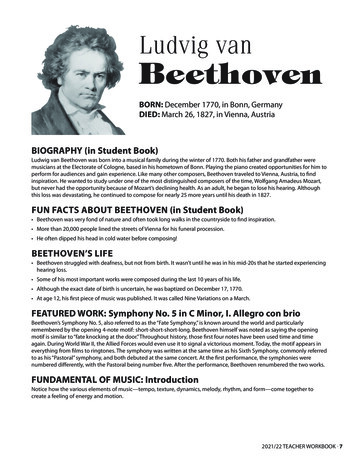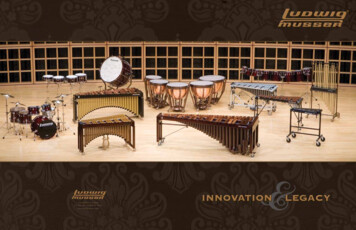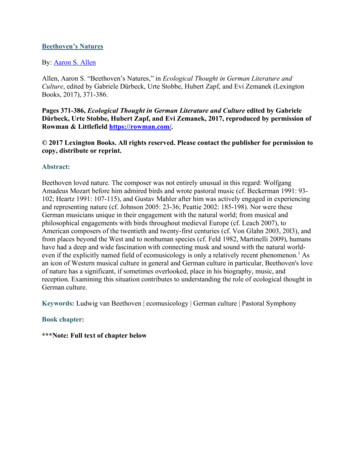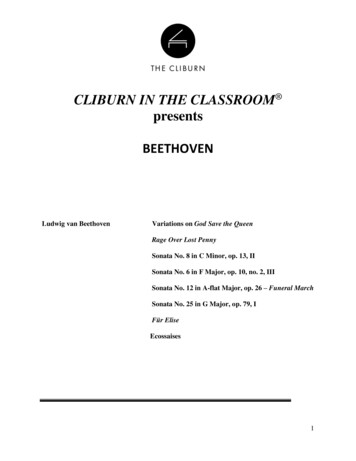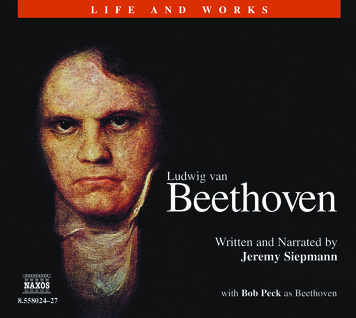
Transcription
L I F EA N DW O R K SLudwig vanBeethovenWritten and Narrated byJeremy Siepmann8.558024–27with Bob Peck as Beethoven
Life and Works: Ludwig van BeethovenPrefaceIf music is ‘about’ anything, it’s about life. No other medium can so quickly or morecomprehensively lay bare the very soul of those who make or compose it. Biographies confinedto the limitations of text are therefore at a serious disadvantage when it comes to the lives ofcomposers. Only by combining verbal language with the music itself can one hope to achieve afully rounded portrait. In the present series, the words of composers and their contemporaries arebrought to life by distinguished actors in a narrative liberally spiced with musical illustrations.The substantial booklet contains an assessment of the composer in relation to his era, anoverview of his major works and their significance, a Graded Listening Plan, a summary ofrecommended books, a gallery of biographical entries on the most significant figures in his lifeand times, and a calendar of his life showing parallel developments in the arts, politics,philosophies, sciences and social developments of the day.Jeremy SiepmannRecorded at Bucks Audio Recording, Buckinghamshire, UK and Hats Off Studios, Oxfordshire, UKEngineers: Alan Smyth, Michael TaylorSound Editors: Simon Weir, Classical Recording Company; Michael Taylor, Ariel ProductionsDesign: Sue Norman. Editor: Hugh GriffithWritten and produced by Jeremy SiepmannCover Picture: Beethoven (Lebrecht Collection, London) 2001 HNH International Ltd. p 2001 HNH International LtdAll rights reserved. Unauthorised public performance, broadcasting and copying of this material prohibited.Distributed by MVD Music and Video Distribution GmbH, Oberweg 21C – Halle V, D-82008 Unterhaching, Munich, Germany.28.558024–27
Life and Works: Ludwig van BeethovenLudwig vanContentsBeethovenTrack ListingsBiographies1 Historical Background: The Eighteenth Century2 Historical Background : The Nineteenth Century3 Beethoven in his Time4 The Major Works and Their Significance5 A Graded Listening Plan6 Recommended Reading7 Personalities8 A Calendar of Beethoven’s Life9 Glossary10 Discography11 Spoken Text8.558024–27469172125465658641001101133
Life and Works: Ludwig van Beethoven132456789101112131415164Childhood and YouthSymphony No.7 in A (finale)Hammerklavier Sonata,op. 106 (exc.)Beethoven as a pianistSonata in C, op. 2 No. 3 (finale)Beethoven as PianistGerman Dance, WoO 8, No. 4Beethoven’s ViennaSextet in E flat, op. 81b(first movement)Beethoven as Friend,Pupil and ArtistTrio in C minor, op. 1 no. 1 (finale)Piano Concerto No. 2 inB flat (finale)The Onset of DeafnessAppassionata Sonata (finale)The Crest of the WaveSeptet in B flat 031Sonata Pathétique, op. 13 (Exc.)3:18Beethoven in Love3:37Piano Sonata in C sharp minor,op. 27, no. 2 (exc.)1:24Symphony no.2 in D, finale (exc.)3:04the Heiligenstadt Testament5:24Funeral March (exc.)3:55Eroica Symphony, finale (exc.)1:52A Winning Streak1:11Beethoven in Crisis:Eroica Symphony:Beethoven and Heroism6:24Beethoven the Revolutionary2:54Razumovsky Quartet No. 1 ,pp. 59 no. 1, Adagio (exc.)3:58Beethoven and Women8:15Violin Concerto in D, op. 61,First movement (exc.)Beethoven the Performer6:24Emperor Concerto, finale (complete)6:5610:008.558024–27
3233343536373839404142434445Beethoven and SufferingCoriolan OvertureBeethoven and FateFifth Symphony, first movement(complete)Fifth Symphony, finale (exc.)Beethoven and theTranscendence of SufferingSeventh Symphony,first movement (exc.)Beethoven, Goethe and Self-pityBeethoven on his Method ofComposingBeethoven and Unrequited LoveSerioso Quartet, op.95,first movementThe Immortal BelovedViolin Sonata in G, op.96,first movementTo the Brink of Suicide – and beyond8.558024–27Life and Works: Ludwig van :527:5946474849505152535455565758596061Battle Symphony (exc.)2:54Archduke Trio4:07Prisoner’s Chorus from FidelioBeethoven ‘kidnaps’ KarlBeethoven’s Manner & AppearancePastoral Symphony (exc.)Beethoven as a ‘parent’Piano Sonata No. 32, Op. 111Beethoven and FriendshipHis Attitudes to PublicationBeethoven as ConductorNinth Symphony (Scherzo) (exc.)His Final WorksString Quartet in B Op. 130 (‘Cavatina’)7:06Music 6: Ninth Symphony (exc.)4:01Beethoven’s Death5:2910:033:005
Life and Works: Ludwig van BeethovenCastJeremy Siepmann – NarratorBob Peck – BeethovenOther parts read by Neville Jason, David Timson, Elaine Claxton and Karen ArcherJeremy SiepmannThough long resident in England, Jeremy Siepmann was born and formally educated in the UnitedStates. Having completed his studies at the Mannes College of Music in New York, he moved toLondon at the suggestion of Sir Malcolm Sargent in 1964. After several years as a freelancelecturer he was invited to join the staff of London University. For most of the last 20 years he hasconfined his teaching activity to the piano, his pupils including pianists of worldwide repute.As a writer he has contributed articles, reviews and interviews to numerous journals andreference works (including New Statesman, The Musical Times, Gramophone, BBC MusicMagazine, The New Grove Dictionary of Music and Musicians), some of them being reprinted inbook form (Oxford University Press, Robson Books). His books include a widely acclaimedbiography of Chopin (The Reluctant Romantic, Gollancz/Northeastern University Press, 1995),two volumes on the history and literature of the piano, and a biography of Brahms(Everyman/EMI, 1997). In December 1997 he was appointed editor of Piano magazine.His career as a broadcaster began in New York in 1963 with an East Coast radio series on thelife and work of Mozart, described by Alistair Cooke as ‘the best music program on Americanradio’. On the strength of this, improbably, he was hired by the BBC as a humorist, in whichcapacity he furnished weekly satirical items on various aspects of American life.After a long break he returned to broadcasting in 1977, since when he has devised, written andpresented more than 1,000 programmes for the BBC, including the international-award-winningseries ‘The Elements of Music’. In 1988 he was appointed Head of Music at the BBC WorldService, broadcasting to an estimated audience of 135 million. He left the Corporation in Spring1994 to form his own independent production company.68.558024–27
Life and Works: Ludwig van BeethovenBob PeckBob Peck was a highly versatile actor in the British tradition. He played manymajor classical roles at the Royal Shakespeare Company, including Macbeth,Lear and Iago as well as taking leading parts in new plays, including Pinter’s TheBirthday Party. At the same time, he was active in films and was seen extensively on television winning the 1985 BAFTA award for Best Actor and the BAMFComedy Award in 1998. He died in 1999. This recording of Beethoven’s Life andWorks was one of his last performances.Neville JasonNeville Jason trained at the Royal Academy of Dramatic Art, where he wasawarded the Diction Prize by Sir John Gielgud. He is a familiar voice on BBCRadio. For Naxos AudioBooks he has abridged and recorded Proust’sRemembrance of Things Past in 12 volumes.David TimsonDavid Timson trained at the Guildhall School of Music and Drama in London, asboth actor and singer. He has performed in modern and classic plays in the UKand abroad, and is a leading voice actor on radio and audiobook. For NaxosAudioBooks he has recorded volumes of Sherlock Holmes stories, and has directed Twelfth Night in which he also plays Feste.Elaine ClaxtonElaine Claxton has worked extensively in UK theatre, including London’s RoyalNational Theatre. She has twice been a member of the BBC Radio Company, during which time she participated in over 200 broadcasts.8.558024–277
Life and Works: Ludwig van BeethovenKaren ArcherKaren Archer has worked for the Royal Shakespeare Company in NicholasNickleby and as Mrs Erlynne in Lady Windermere’s Fan, as well as across the UKin plays such as Ghosts, She Stoops to Conquer and Who’s Afraid of VirginiaWoolf? Her television appearances include The Chief, Ruth Rendell Mysteries,Casualty and Chancer and she has been seen in the films The Secret Garden andForever Young.88.558024–27
Life and Works: Ludwig van BeethovenHistorical Background: The Eighteenth Century1OverviewThe eighteenth century has rightly been called ‘the century of revolutions’ (though the nineteenthcan lay equal claim to the title), but the most lasting of these, on the whole, were agricultural,industrial and scientific, not military or political. Human knowledge expanded to anunprecedented degree, with effects on daily life which would eventually eclipse the transientdecisions of governments and rulers. Wars, as ever, proliferated, with five in particular having themost lasting impact: the Wars of the Spanish and Austrian Succession, the Seven Years War andthe American and French Revolutions. Despite the gathering groundswell of democracy, absolutemonarchies continued to flourish in most parts of the world. Prussia and Russia (the latter,ironically, under the Prussian-born Catherine the Great) became world powers, French powerdiminished under the increasingly inept rule of Louis XV and Louis XVI, the British Empireexpanded, most dramatically in India, and America became a major player on the internationalpolitical stage. More important, however, than any armed insurrection or expansionist militarycampaign was the emergence of an increasingly powerful and independent middle class. Morethan any previous century, the eighteenth was a century of commerce.World trade was an immediate beneficiary of the improvements in transport andcommunications which flowed from the scientific and technological advances then taking place8.558024–279
Life and Works: Ludwig van Beethovenon almost every front. By the mid-century, raw materials were being imported from countries allover the world, often to the social and economic disadvantage of the exporting nations. Europe,on the other hand, profited hugely, exporting a wide range of goods and spawning a large quantityof financial institutions – banks, stock exchanges, insurance companies, and so on. Cheques wereincreasingly used in place of cash, and the proliferation of paper money increased the amounts apedestrain could easily carry. For the newly well-to-do, shopping became a pastime as well as abusiness.Science and TechnologyThe eighteenth century was a veritable festival of exploration and discovery, in medicine,mechanics, physics, chemistry and many other fields, including weaponry. Here, as elsewhere,ingenuity sometimes outstripped practicality, as in the ill-fated, one-man, hand-cranked Turtlesubmarine launched into the depths off the east coast of America in 1755. More useful wasHarrison’s marine chronometer of 1735, which enabled sailors to pinpoint their exact position atsea; more lethal were Wilkinson’s precision-boring cannon of 1774 and Bushnell’s invention ofthe torpedo in 1777. On more peacable fronts, the period saw the discovery and first harnessingof electricity, most famously by Benjamin Franklin, inventor of the lightning conductor, and theItalian Alessandro Volta, who invented the electrical battery and whose surname, minus the ‘a’,has long since become a household word. Another similarly honoured was James Watt, whoseimprovement of Newcommen’s steam engine in 1764 precipitated the Industrial Revolution (theterm ‘watt’, incidentally, refers to a unit of power rather than to anything exclusively electrical).Other notable inventions include Chappe’s telegraph (a mechanical form of semaphore used torelay coded messages over long distances) and the hydraulic press.Among many significant medical advances which substantially improved the quality of life, themost important was the discovery of a vaccine against smallpox – but not before one epidemickilled 14,000 people in Paris alone. An unforeseen side effect of middle-class affluence and108.558024–27
Life and Works: Ludwig van Beethovenimproved standards of public and personal hygiene was an increase in population which threatenedto outstrip the food supply. Although many did indeed starve, the era saw more and greater changesin agricultural methods than had occurred for many centuries. Farming became a major industry asthe demand for food and wool increased. But of all eighteenth-century revolutions, none had morefar-reaching consequences than the Industrial Revolution.Originating in Britain at around the time of Beethoven’s birth in 1770, it owed its initialimpetus to the invention of the steam engine, first used as a means of draining mines but rapidlyput to use in factories. With the unprecendented proliferation of new machinery which vastlyincreased the speed and output of manufacturing, England became known as ‘the workshop of theworld’, and prospered accordingly. The revolution soon spread to other countries, shifting thebalance of power from the aristocratic landowner to the industrial capitalist and creating a largeurban (and increasingly vocal) working class.Political MovementsYet despite a burgeoning, increasingly prosperous middle class, which made much of ‘goodmanners’ and the trappings of gentility, the great majority of the population, in Europe aselsewhere, continued to live in poverty, suffer ill health and die early. Education for the poor wasminimal, illiteracy and crime were rife, child labour commonplace and political representationgenerally non-existent. In the Old World and the New, slavery continued unchecked, although anincreasing number of Europeans, particularly in Britain, found the practice repugnant.Throughout Europe, indeed in many parts of the world, the traditional ruling classes cameincreasingly under threat. Of the numerous insurrections which erupted in the eighteenth century,the first of world significance was the American Revolution (1776–1783), from which emergedthe newly independent United States, a country of vast resources whose political creed,resoundingly based on libertarian principles and clearly set out in its Declaration of Independenceand formal Constitution, served as a beacon to oppressed minorities elsewhere, and undoubtedly8.558024–2711
Life and Works: Ludwig van Beethovenemboldened the disaffected in France, whose own revolution, initiated by the storming of theBastille in July 1789 and lasting effectively until Napoleon’s seizure of power ten years later, wasto be the bloodiest, and in some ways the most counter-productive, in history. In 1793 alone,during the infamous Reign of Terror, more than 18,000 people were publicly beheaded. In themeantime, the revolutionary government (in reality a sequence of them) was simultaneously atwar with most of Europe, which justifiably feared that the revolution might spread beyond Frenchborders.ReligionAs ever, religion remained both inspirational and contentious. Though there were some signs ofincreased tolerance in certain quarters – as in England, which saw the founding of Methodism byJohn Wesley in the 1730s and of the Shaker sect in 1772, and, rather surprisingly, in Russia, whereCatherine the Great granted freedom of worship in 1766 – religious bigotry continued to flourish,particularly in the relations of Protestants and Roman Catholics. 1731 saw the expulsion of20,000 Protestants from Salzburg (most of whom emigrated to America), and the Jacobite risingin the mid 1740s, like the viciously anti-Catholic Gordon Riots of 1780, demonstrated the fragilelimits of religious tolerance in Britain. Nor was the appeal in 1781 by the German philosopherMoses Mendelssohn (grandfather of Felix) for better treatment of the Jews either the first or thelast. While not as widespread as in the previous century, superstition was still rife amongst theless educated classes throughout the western world.IdeasThe eighteenth century, following on from the rationalist trends of the previous century, was theage of the Enlightenment, one of the richest eras in the history of western philosophy. Thinkersin every sphere of endeavour, influenced by the quickening flood of scientific discovery, placedever greater faith in reason as the gateway to truth and natural justice. Highly critical of the status128.558024–27
Life and Works: Ludwig van Beethovenquo and hostile to religion, which they saw as enslaving humanity with the chains of superstition,their writings reached a wide audience and contributed directly to the underlying ideals of theAmerican and French Revolutions. Though based mainly in France, where its principalproponents were Diderot, Voltaire and Rousseau, the movement attracted other importantthinkers, most notably the Scots David Hume and Adam Smith, the American Thomas Paine andthe Germans Immanuel Kant and Gotthold Lessing. Voltaire and Rousseau, in particular, usedsatire as a potent political weapon, and Diderot presided over one of the greatest works ofscholarship ever produced, the 28-volume Encyclopédie, completed in 1776 and including 17volumes of text and 11 of illustrations. Rousseau’s Discourses on the Origins of Inequality (1754)pilloried the decadent effects of civilization and proclaimed the superiority of the ‘noble savage’.His Social Contract of 1762 emphasized the rights of people over government and exhortedpeople everywhere to overthrow all governments not representing the genuine will of thepopulation. Both books are among the most influential ever written. Adam Smith was aneconomist whose great work The Wealth of Nations (1776) took the revolutionary step of definingwealth in terms of labour, and advocating individual enterprise and free trade as essentials of ajust society. Hume’s best-known philosophical work, A Treatise of Human Nature (1740), is anattack on traditional metaphysics and suggests that all true knowledge resides in personalexperience. Kant, on the other hand, argued that right action cannot be based on feelings,inclinations or mere experience but only on a law given by reason, the so-called ‘categoricalimperative’. The subject of Thomas Paine’s famous book The Rights of Man is self-explanatory.The ArtsThe eighteenth century saw the birth and early development of of the modern novel with theworks of Daniel Defoe (Robinson Crusoe, Moll Flanders) and Samuel Richardson (Pamela,Clarissa). Above all, however, it was a century of great poets who effectively created theRomantic movement which was to find its musical manifestation in the nineteenth century. Pre8.558024–2713
Life and Works: Ludwig van Beethoveneminent amongst them were the Germans Goethe and Schiller, closely followed by the BritonsBlake, Wordsworth and Coleridge. But it was also the century of the great philosopher-satirists,of whom the greatest were Voltaire (Candide), Swift (Gulliver’s Travels) and Jean-JacquesRousseau (see above, under Ideas). Satire was also conspicuous in the realm of painting, as in thework of William Hogarth (The Rake’s Progress). The greater painters and sculptors were amongthe finest portraitists who ever lived: David, Gainsborough, Reynolds, Chardin (whoprophetically turned his attentions away from the upper classes and painted the lower bourgeoisieand working classes), Goya (his grim ‘romantic’ visions came in the next century) and Houdon,whose sculptures of Voltaire, Jefferson and Washington are almost eerily lifelike. Amongst thegreatest scholars and men of letters was Samuel Johnson, whose monumental Dictionary of theEnglish Language (1755) was the first ever compiled. In the realm of dance, the eighteenthcentury saw the rise of modern ballet, centred, like so much else, in France. The most influentialfigures were the ballerina Marie-Anne Camargo, who in 1720 took the revolutionary step ofshortening the traditional flowing, court-style dresses to reveal the feet and legs, thechoreographer Jean-Georges Noverre (Les Petits riens) and the composer Jean-Philippe Rameau.ArchitectureExcept in the upper reaches of society, domestic architecture in eighteenth-century Europechanged relatively little. That of public buildings and the dwellings of the well-to-do changeddramatically, on both sides of the Atlantic. The grandiose and ornate gestures of the Baroque eragave way to simpler styles, many of them strongly influenced by the graceful majesty of classicalGreek and Roman designs. Famous examples are the White House and Capitol building ofWashington D.C., ‘Monticello’, Thomas Jefferson’s home in Virginia (designed by himself) andthe Royal Crescent at Bath in England. With the proliferation of new cities spawned by theIndustrial Revolution and the steady expansion of the United States, architects and town plannersturned their attentions to the design not only of buildings but of towns and cities themselves. The148.558024–27
Life and Works: Ludwig van Beethovengridiron pattern of Manhattan Island in New York is the fruit of just such planning, and was to beduplicated in many American cities. Here the regularity and symmetry of the neo-classicalapproach had a thoroughly practical purpose: with this scheme, cities could be indefinitelyextended in any direction. A striking feature of industrial architecture, in particular, was the useof new materials such as cast-iron.MusicThe eighteenth century saw the culmination of the Baroque in the great works of Bach andHandel, and the finest flowering of the Classical era which succeeded it. Domenico Scarlatti wasthe exact contemporary of Bach and Handel but such was the astounding originality and exoticnature of the keyboard sonatas which have kept his name alive that he stands largely outsidemainstream trends and developments. In some respects, his most important music is closer inspirit and style to the Romantics of the nineteenth century than to anything else written in his owntime. If the defining features of the Baroque style (or to be truer to reality, the Baroque family ofstyles) was a combination of grandiosity and polyphony (counterpoint; see Glossary) with a highdegree of ornamentation, the Classical era represents an era whose relative simplicity of harmony,texture and style was entirely in keeping with the ascent of the middle-class and the progressiveweakening of the aristocracy. The learned, long-lined contrapuntal weaves of the Baroque gaveway to the more straightforward texture of melody and accompaniment, often simple brokenchords in a pattern known as the Alberti bass (see Glossary), and the basic harmonic vocabularybecame much simplified. Most music written in the Classical era (roughly 1750–1820) is basedon an economical framework of four or five basic chords (triads; see Glossary) and draws itsmaterial from two or three relatively short, self-contained melodic ‘themes’, frequently of asimple, folk-like character. Not only themes but phrases tend to become shorter and more regularthan in most Baroque music. Large-scale structures, too, become generally clearer and moresymmetrical, showing clear analogies with the classical architecture of the ancient Greeks and8.558024–2715
Life and Works: Ludwig van BeethovenRomans. Along with a somewhat ritualised approach to form comes a more formal, more‘objective’ approach to the expression of emotion. It’s often easier to describe the contour of aclassical theme than it is to associate it with a particular mood. The prevailing virtues aresymmetry, order, refinement and grace. The most significant contribution of the classical era tothe history of music is the crystallization of Sonata Form (see Glossary), brought to its highestpeak by Mozart, Haydn and Beethoven. Virtually all of the great works of the classical era arebased on it. The principal genres of the period – sonata, string quartet, concerto and symphony –are all, in fact, sonatas, differing only in the size and character of the chosen instrumentalmedium.Standing largely apart from this development is the parallel evolution of opera, dominated inthe first half of the century by Handel and Rameau and in the latter by Mozart and Gluck(1714–87). Because he confined himself for the most part to opera, Gluck’s name tends to get leftout when people refer loosely to the Classical era, but he was one of the giants. His greatness liesin the quality of his music but his long-term significance derives from his radical reforms, whichdid much to simplify and purify an art which had become overladen with irrelevant conventions,complicated by labyrinthine love plots and disfigured by an excessive attention to virtuosity forits own sake. He derived his plots from classical Greek mythology (Orfeo ed Euridice, Iphigénieen Aulide, Armide etc.), suited the music to the emotional and dramatic requirements of hislibretto, softened the distinction between recitative and aria [see Glossary], paid scrupulousattention to subtleties of character development and elevated the role of the chorus (another nodto the classical Greeks). Mozart, although his operas (Don Giovanni, The Marriage of Figaro,Cosí fan tutte, The Magic Flute etc.) are perhaps the greatest ever written, was not a reformer.168.558024–27
Life and Works: Ludwig van BeethovenHistorical Background: The Nineteenth Century2OverviewThe nineteenth century, especially in Europe and North America, was an era of unprecedentedchange, peppered, inevitably, with wars and revolutions of almost every kind and at every levelof society. The continuing advance of the Industrial Revolution, while far from abolishingpoverty, brought new wealth to an ever-expanding middle class, factories proliferated throughoutEurope, soon exceeding the supply of indigenous raw materials and thereby intensifying theimpulse towards colonization. The British Empire increased its dominions dramatically, Africawas carved up by Britain and other European colonists, and despite increasing unease, the slavetrade continued, though its days were numbered. Alarmed by European expansionism, China andJapan attempted to shut out the West altogether. But empire-building went on apace withinEurope itself, never more dramatically than during the Napoleonic Wars (1799–1815) , which hadthe incidental effect of igniting in countries from Italy to Russia a fervent nationalism which wasto become a running feature of the century as a whole.Science and technology, as in the previous century, had expanded human knowledge to anunprecedented degree. When Joseph Lalande published his catalogue of 47,390 stars in 1801, heheralded a century of astronomical discovery, both literal and figurative.Agriculture, easily sidelined by the achievements of the Industrial Revolution, experienced8.558024–2717
Life and Works: Ludwig van Beethovenrevolutions of its own, with breeding experiments leading to ever bigger crops and fatter animals.Cyrus McCormick invented his reaping machine in America, heralding a new age of mechanizedharvesting.IdeasAs might be expected in a time of such ferment, the century was rich in philosophers, though theideas which had, and continue to have, the most impact came from other quarters.Philosophically, the highground was held by the Germans, much as the French had held it in theprevious century. The great names of the Beethoven era included Hegel (1770–1831) andSchopenhauer, (1788–1860), both of whom were much concerned with music in one way oranother. Hegel argued that consciousness and the world of external objects were inseparableaspects of a single whole, and that truth is discoverable only through a dialectic process ofcontradiction and resolution – a thoroughly rationalist idea with clear parallels in the concept ofsonata form [see Glossary]. Schopenhauer took a more pessimistic view (and one more in keepingwith the preoccupations of the Romantics), in which the irrational will is seen as the governingprinciple of our perception, dominated by an endless cycle of desire and frustration from whichthe only escape is aesthetic contemplation. His thinking was to have a powerful effect on bothWagner and Nietzsche, who rejected established concepts of Christian morality, Nietzscheproclaiming that ‘God is dead’ and postulating the ideal of the Übermensch, or ‘Superman’, whowould impose his self-created will on the weak and the worthless – a view fully in keeping withthe gargantuan nature of the romantic ego, with its roots in the controlling powers of the IndustrialRevolution and the spate of scientific discoveries which granted Man an ever greater mastery ofhis environment.The ArtsIn the realm of literature it was the century of the novel, pioneered in England by Jane Austen and188.558024–27
Life and Works: Ludwig van BeethovenSir Walter Scott, and in Germany by Goethe, Jean-Paul Richter and the fantastical E.T.A.Hoffmann (whose critical writings on Beethoven rank with the most perceptive and influentialever written).ArchitectureNineteenth century architecture in Europe and America reflected both the Romantic obsessionwith the past and the industrialists’ concerns with practicality and economy. Public buildingstended for most of the century toward an ever more massive grandiosity, drawing on a widevariety of styles ranging from the distant to the recent past, often within a single building. Afamous example is the Palace of Westminster (better known as the Houses of Parliament) inLondon.MusicNever has an art known greater changes in so relatively short a time than music in the nineteenthcentury. When the century began, Beethoven was only 30, Schubert only three and Haydn (68)was still at the height of his powers. When it ended, Debussy’s revolutionary Prélude a l’Aprésmidi d’un Faune, often cited, even today, as ‘the beginning of modern music’, was already sevenyears old, and Schönberg (26), Ives (also 26), Bartók (19) and Stravinsky (18) were all fullyactive. In between, the end of the Classical era and t
Life and Works: Ludwig van Beethoven 8.558024–27 3 Ludwig van Track Listings 4 Biographies 6 1 Historical Background: The Eighteenth Century 9 2 Historical Background : The Nineteenth Century 17 3 Beethoven in his Time 21 4 The Major Works and Their Significance 25 5 A Graded Listening Plan 46 6 Re
